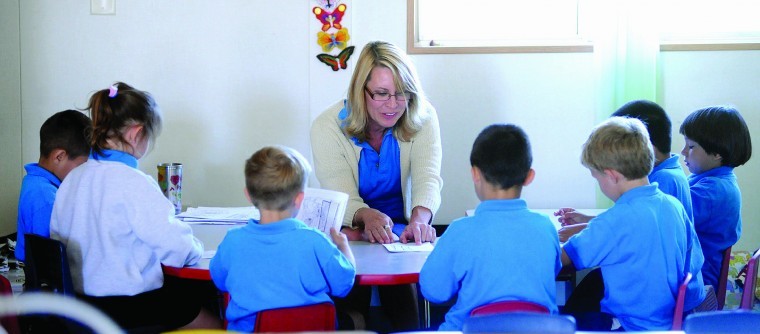Math teacher Heather Parsons has full grasp of her students’ attention, and Gilroy Prep would have it no other way.
Parsons on a recent Wednesday proceeded through a lesson on decimal places. She displayed a number at the front of the classroom and asked a question, then called for “proofing and dis-proofing” session from the students and played “Harry Potter” theme music to signal a countdown of sorts as students gave their answers on remote devices. Parsons, meanwhile, used a wireless mouse to interact.
“Kids get instant gratification,” said Principal James Dent, as he watched the teaching method unfold. “She knows exactly on her list who needs remediation.”
Hollister area residents recently toured Gilroy Prep School and heard a presentation from staff officials who talked about plans to open a similar charter school in San Benito County. On May 23, Dent led the tour of the 180-student campus at 277 IOOF Ave. near downtown Gilroy and made a presentation afterward, taking questions from attendees.
Dent indicated the school has plans to create a “network” of charter campuses on the Central Coast, including one in Hollister in 2013-14, ideally at the R.O. Hardin School site. He discussed Gilroy Prep’s model, based on other successful charter schools in the state, and the improved results at certain schools coinciding with the alternate teaching methods – largely focused on consistently proper behavior, keeping students engaged and using technology in the classroom.
As Dent explained to visitors, Gilroy Prep has modeled itself after several successful charter schools in the state – such as KIPP Hartwood Academy in San Jose and Sixth Street Prep in Victorville – which have showed significantly improved results in largely disadvantaged areas. He noted how public schools that have attempted to replicate similar models of teaching also have shown major improvements in recent years.
The goal is to do the same at Gilroy Prep and eventually in Hollister, which has shown similarly disproportionate results between advantaged and disadvantaged students.
“We want to figure out how to do it best and share that knowledge,” Dent told the visitors. “Schools can have incredible benefits when they work together.”
GPS currently offers grades kindergarten through second, has a total staff of 11 – including six paraprofessionals who are not certificated – and will expand another level each year up to the eighth grade. It has its own board of education and is a Title I school, meaning its aim is to improve academic achievement of disadvantaged students.
Parents are required to volunteer, while one of them was leading a small group of students in reading exercises during the tour.
“It’s a very close-knit community,” Dent said.
The facility has six portable classrooms, an administrative office, one computer lab and a cafeteria. GPS is paying its teachers about 7 to 10 percent higher than the average GUSD teacher of the corresponding skill set and experience level, while the school maintains $400,000 reserve with trends showing more than $1 million by the end of 2013-14.
Financial stability was the focus of one question from the audience, as retired teacher Louise Ledesma wondered how they do it. Dent noted that the school invests much of its resources into the staff and avoids the type of traditional spending from public schools, such as buying books in bulk and paying a full-time custodian with benefits (GPS pays three people to do it part time with no benefits). As for rent, the district provides the space, while the charter pays 3 percent of its revenue to Gilroy Unified.
While teachers can earn more at the charter school, there also is a focus on accountability. Staff members are at-will employees, meaning they can be fired for bad behavior or poor performances.
“It’s more like a business in that way,” Dent said, comparing the model with public schools having tenure.
Language arts teacher Crystal Toriumi was in the question-answer session and offered a personal anecdote on her own experience. As a teacher at Eliot Elementary in Gilroy, she had received a pink slip year after year and would get called back right before school started. When finally offered tenure, with an offer on the table from GPS, she turned it down.
“I wasn’t sure,” she said. “I have zero regrets.”
There is more accountability for the students, too, with frequent assessments and progress reports each month.
Other differing practices include extended school days that amount to nine additional weeks of instruction per year, a focus on state standards and use of technology – GPS plans to have iPads in the classrooms next year. Dent said Gilroy Prep reduces special education referrals compared with public schools as well.
“We’re just not going to do it because we believe the quality of education we’re giving in the classroom, plus the interventions and the computer use, is better than a special education program anyway,” he said.
Once GPS expands, its leaders believe the network of schools will provide opportunities for loaning staff or money among the campuses. He said the charter school network would build its administration through current staff to ensure practices are consistent. He said teachers could “come from anywhere.”
“The more Hollister flavor we get, the better.”










